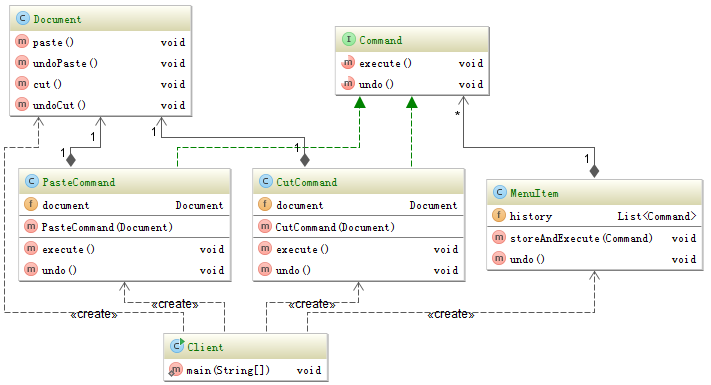Java command pattern example 2017-01-18 01:42
Four roles in command pattern are client, invoker, receiver and command. Command invokes a method of Receiver to finish one command. Invoker knows which command will be executed. Invoker and Receiver do not know each other. After packaging the command you can repeat or undo it.
The structure of command pattern is like following.
Command interface and concrete commands
public interface Command {
void execute();
void undo();
}
public class CutCommand implements Command {
private Document document;
public CutCommand(Document document) {
this.document = document;
}
@Override
public void execute() {
document.cut();
}
@Override
public void undo() {
document.undoCut();
}
}
public class PasteCommand implements Command {
private Document document;
public PasteCommand(Document document) {
this.document = document;
}
@Override
public void execute() {
document.paste();
}
@Override
public void undo() {
document.undoPaste();
}
}
The implements of cut and paste operation are in Document (receiver).
public class Document {
public void paste(){
System.out.println("paste word into document");
}
public void undoPaste(){
System.out.println("undo paste word into document");
}
public void cut(){
System.out.println("cut word from document");
}
public void undoCut(){
System.out.println("undo cut word from document");
}
}
Invoker (MenuItem) will invoke different commands and record them.
public class MenuItem {
private List<Command> history = new ArrayList<>();
public void storeAndExecute(Command command) {
history.add(command);
command.execute();
}
public void undo() {
for (int i = history.size() - 1; i >= 0; i--) {
history.get(i).undo();
}
}
}
The code of client is like following.
public class Client {
public static void main(String[] args) {
MenuItem menuItem = new MenuItem();
Document document = new Document();
CutCommand cutCommand = new CutCommand(document);
PasteCommand pasteCommand = new PasteCommand(document);
menuItem.storeAndExecute(cutCommand);
menuItem.storeAndExecute(pasteCommand);
menuItem.undo();
}
}
